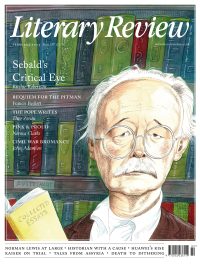Stuart Jeffries
Planet of the Living Dead
The Future Loves You: How and Why We Should Abolish Death
By Ariel Zeleznikow-Johnston
Allen Lane 360pp £25
‘I wish it were possible’, wrote the American polymath Benjamin Franklin in 1773, ‘to invent a method of embalming … persons, in such a manner that they might be recalled to life at any period.’ Two hundred and fifty years later, Ariel Zeleznikow-Johnston, a young Australian neuroscientist, argues in this riveting book that we not only can but also should cheat death by means of a mind-bogglingly complex process called vitrifixation. This involves posthumously draining the body of fluids and replacing them with an anti-freeze compound called cryoprotectant before storing the body at minus 130 degrees centigrade until such time as it might be reanimated in a world in which medicine has advanced sufficiently to treat deadly human ailments.
Not only should our bodies be cryogenically frozen. Our brains should also be infused with fixatives such as formaldehyde and glutaraldehyde in order to stabilise neurons, synapses and complex molecules. This would successfully preserve what neuroscientists call the connectome. What, you might be wondering, is a connectome? The word is a neologism, coined in homage to the term ‘genome’. ‘In containing and specifying all of your mental attributes … and in uniquely defining you out of all the other people who could be, your connectome is the physical manifestation of your personal identity,’ Zeleznikow-Johnston explains. Your connectome is substrate neutral, meaning that it can, in principle, be digitised and downloaded from your body. It might even be possible to use the connectome to create a digital avatar with no physical form which will quite happily inhabit virtual reality forever.
The devil, as you might suspect, is in the detail (I found myself writing ‘Really? How?’ in the margins a great deal). When the cryogenically frozen are defrosted back to life, existential problems are likely to arise. Being thawed, then digitised and uploaded to a new body might well be

Sign Up to our newsletter
Receive free articles, highlights from the archive, news, details of prizes, and much more.@Lit_Review
Follow Literary Review on Twitter
Twitter Feed
It wasn’t until 1825 that Pepys’s diary became available for the first time. How it was eventually decrypted and published is a story of subterfuge and duplicity.
Kate Loveman tells the tale.
Kate Loveman - Publishing Pepys
Kate Loveman: Publishing Pepys
literaryreview.co.uk
Arthur Christopher Benson was a pillar of the Edwardian establishment. He was supremely well connected. As his newly published diaries reveal, he was also riotously indiscreet.
Piers Brendon compares Benson’s journals to others from the 20th century.
Piers Brendon - Land of Dopes & Tories
Piers Brendon: Land of Dopes & Tories - The Benson Diaries: Selections from the Diary of Arthur Christopher Benson by Eamon Duffy & Ronald Hyam (edd)
literaryreview.co.uk
Of the siblings Gwen and Augustus John, it is Augustus who has commanded most attention from collectors and connoisseurs.
Was he really the finer artist, asks Tanya Harrod, or is it time Gwen emerged from her brother’s shadow?
Tanya Harrod - Cut from the Same Canvas
Tanya Harrod: Cut from the Same Canvas - Artists, Siblings, Visionaries: The Lives and Loves of Gwen and Augustus John by Judith Mackrell
literaryreview.co.uk